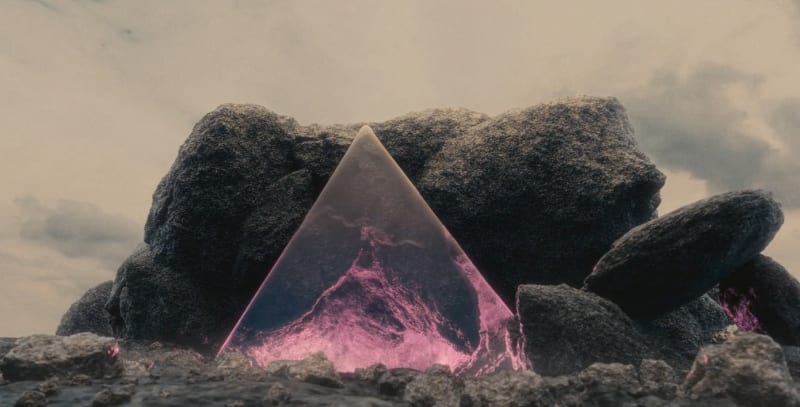Erotic Geologies: Natalie Tozer
Merchant bankers Rangi and Liberté are flung into hostile and unfamiliar ground after an earthquake renders their office into rubble. Lost in a world they don’t understand, they wander the harsh terrain, unwittingly seeking refuge in the sunken troves of geology. This is an underground that has no time and no exit. Trapped until they receive the necessary Chthonic knowledge, they’re finally released into the open air, emerging to find immemorial time has passed, a geological age has passed… everything has passed. Taking what they learned from their captivity underground Rangi and Liberté ascend to the highest mountain top to complete their survival task – to ‘throw the bones of the mother’ (stones of mother earth).
Erotic Geologies is a sci-fi parable that seeks knowledge from the underground. Shifting through an otherworldly landscape where rocky outcrops meet tumultuous skies, the setting of the film makes reference to post-earthquake Ōtautahi in Te Waipounamu and the Tongariro Crossing in Te Ika-a-Māui. The narrative follows protagonists Rangi and Liberté, characters inspired by both Māori mythologies surrounding the figures of Ranginui and Papatūānuku’s children, and Greek figures Deucalion and Pyrrha. Archaeology, time and kaitiakitanga are central to the work which merges a local, contemporary narrative with deep time and mythology.
An excerpt of this film can be viewed below.
With thanks to:
Erotic Geologies is a sci-fi parable that seeks knowledge from the underground. Shifting through an otherworldly landscape where rocky outcrops meet tumultuous skies, the setting of the film makes reference to post-earthquake Ōtautahi in Te Waipounamu and the Tongariro Crossing in Te Ika-a-Māui. The narrative follows protagonists Rangi and Liberté, characters inspired by both Māori mythologies surrounding the figures of Ranginui and Papatūānuku’s children, and Greek figures Deucalion and Pyrrha. Archaeology, time and kaitiakitanga are central to the work which merges a local, contemporary narrative with deep time and mythology.
The feeling of the film is one of constant movement. The camera circles and pans as the protagonists grapple with a geology that shifts, renews and reforms. Tozer is interested in cycles of renewal. She comments "The virtual world they exist in continually loops, promoting a natural, constant flow of decay and renewal. This is an often notable philosophical difference between a capitalist world view and an indigenous world view." Time becomes cyclical as opposed to linear. This also nods to the ‘one-take’ cinema tradition – a long continuous shot by a single camera from start to finish. The expression of time is layered in both the structure and the narrative of Erotic Geologies, each informing the other. The work magnifies the human experience of living on a biological scale within the extended, deep time of geological formations. The way the environment erodes and reforms, between Anthropocene geology and Holocene geology, directly leads the character development.
The transformative experience of going underground presents itself in distinct ways across many popular science fiction feature films, but when the protagonist emerges from their journey under the earth, the result is always the same – they know something new, and an alternative future is possible. Tozer writes, ‘The fractured, slumping and metamorphic layers underground are the stronghold keepers of knowledge.’ It is this knowledge the protagonists are exposed to as they venture into lithic, cavernous surrounds. Today, access to land is highly restricted and difficult to access financially, especially for younger generations, Tangata Whenua and the indebted. In the alternative archaeology of this world, the ground is raw, open and accessible while retaining full reign over its inhabitants.
Technically, Erotic Geologies was created with green screen live-action, shot on a 6K Red Camera at 48fps to generate footage, which was then composited in a 3D world with local land features based on NASA geodata (such as Tongariro). It includes Lidar scanned geometry of performers, public art and architecture including Marté Szirmay’s Smirnoff Centenary Sculpture, 1969 in Newmarket, Guy Ngan's bronze sculpture for the Newton Post Office, 1973 and Frances Hodgkins’ painting Still Life in front of Courtyard, 1930. Previous titles of the work include Deucalion & Pyrrha (2022) and An Alternative Archaeology (2021). Deucalion & Pyrrha was selected for the Sluice Biennial in Lisbon, Portugal in 2022. We are delighted to present the work's Aotearoa premiere, with its permanent title Erotic Geologies, which marks the work’s completion.
Tozer holds an MFA with first-class honours (2022) from the University of Auckland Waipapa Taumata Rau. During her studies she received The Lightship Award which funded the presentation of an open-air 110m video work at The Ports of Auckland; was selected for a summer scholarship and received an academic scholarship. Recent exhibitions include ABSTRAXT ABSTRAXT at Northart (2024), The Metamodern in Literature, Art, Education, and Indigenous Cosmologies: An Interdisciplinary Symposium at AUT (2023), Deucalion & Pyrrha, Sluice Biennial, PADA Residency, Lisbon Art Weekend (2022), Māter Mater at Silo 6 (2022) and Companion Pieces at Public Record (2021).









